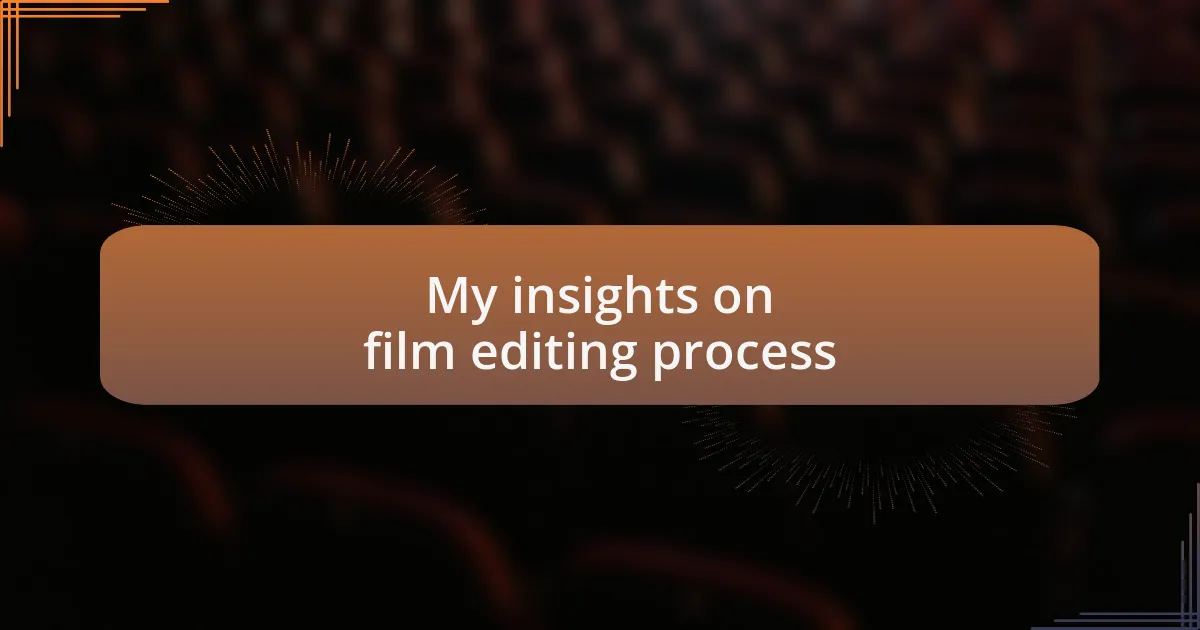Key takeaways:
- Film editing is a crucial process that shapes the narrative and emotional impact of a film.
- Challenges in editing include managing footage volume, maintaining pacing, and balancing personal attachment with storytelling needs.
- Effective editing requires a solid plan, taking breaks for fresh perspectives, and utilizing sound to enhance the narrative.
Author: Evelyn Hartwood
Bio: Evelyn Hartwood is a captivating storyteller and novelist known for her richly woven narratives and complex characters. With a passion for exploring the intertwining of human emotions and the natural world, her works often blend elements of magical realism with contemporary themes. A graduate of the Iowa Writers’ Workshop, Evelyn has published several acclaimed novels and short stories in prestigious literary magazines. When she’s not writing, she enjoys hiking in the mountains of her Pacific Northwest home and nurturing her garden. Evelyn continues to inspire readers with her unique voice and profound insights into the human experience.
Understanding film editing process
Film editing is often described as the invisible art, but in my experience, it’s one of the most crucial aspects of filmmaking. I remember my first project where I spent countless hours piecing together footage. Each cut felt like choosing the right words in a conversation, shaping the story and pacing in a way that could evoke feelings from the audience. Have you ever watched a film and felt that the rhythm was just perfect? That’s the magic of editing at work.
During the editing process, I often find myself wrestling with the footage. It’s like sculpting; you start with a raw block and carve out the essence of the story. I recall one time when a seemingly trivial scene suddenly struck me as pivotal after several revisions. This is where patience becomes essential—editing isn’t just about making things look good; it’s about ensuring that every frame contributes to the overarching narrative. How do you determine what stays and what goes? That decision-making can sometimes be gut-wrenching but ultimately rewarding.
The collaboration aspect of editing is fascinating, too. I’ve partnered with directors who had bold visions, and our discussions would often lead to unexpected creative solutions. It really amplifies the project when different perspectives come together during this phase. Have you ever brainstormed with a team and felt that collective spark of creativity? That’s how I see editing—it’s a blend of technical skill and emotional insight, where the heart of the film truly comes alive.
Challenges I faced in editing
Editing a film can sometimes feel like navigating a maze. One challenge I faced was dealing with footage that didn’t quite match the vision I had in my mind. I distinctly remember a scene that I thought was powerful, but it fell flat during the editing process. It was a real struggle to let go of that scene, especially since I had invested time and emotion into it. Have you ever held onto something that just didn’t work, even when your instincts told you otherwise? It took me time to accept that in editing, sometimes you have to prioritize the overall story over personal feelings about individual clips.
Another hurdle was managing the sheer volume of footage. After wrapping a shoot, I found myself sifting through hours of material, which quickly became an overwhelming task. I recall sitting in front of my computer, feeling lost amidst countless takes when suddenly, clarity struck. I had to create a system—labeling, tagging, and even making rough cuts to help streamline my process. This organization was key; without it, I would have drowned in the chaos. Have you ever felt overwhelmed by a project, and then found a way to regain control? That’s the beauty of establishing your own workflow; it helps transform the chaos into a more manageable process.
Lastly, fine-tuning the pacing often felt like walking a tightrope. I’ve had moments where I believed a scene flowed well, only to discover, through feedback, that it dragged on too long. One memorable project had a crucial reveal, and I had to experiment with different cuts repeatedly before finding the right rhythm. It’s frustrating to hear that something isn’t working, yet it’s also where the real growth happens. How do you find that balance between tension and release? In my experience, it involves constant revisiting and listening to feedback; it’s a humbling yet essential part of the journey.
Tips for effective film editing
When it comes to effective film editing, I’ve learned that a solid plan is essential. Early in my editing journey, I tackled a project without a clear vision and ended up with a jumble of clips that didn’t convey my message. Did you ever dive deep into editing only to realize you were editing for editing’s sake? Crafting a storyboard or a rough cut before diving into the details can save countless hours and keep your narrative focused.
Another invaluable tip is to take breaks during the editing process. I remember burning the midnight oil, convinced that I could power through those final cuts in one go. However, after stepping away for just a brief moment, I returned with fresh eyes and found mistakes I’d completely missed before. Have you ever felt stuck on a project, only to have a breakthrough after a little time away? Sometimes, stepping back allows your subconscious to work through the nuances, and those “aha” moments often lead you to the perfect edit.
Lastly, don’t underestimate the power of sound and music. In one of my films, there was an emotionally charged scene where the right score transformed the viewer’s experience entirely. I had thought about leaving it silent, but once I added a subtle background track, it connected the audience to the story on a deeper level. Have you considered how sound can elevate your narrative? Finding the perfect audio elements can turn a good edit into a memorable one, so always invest time in choosing the right sound to support your visuals.
